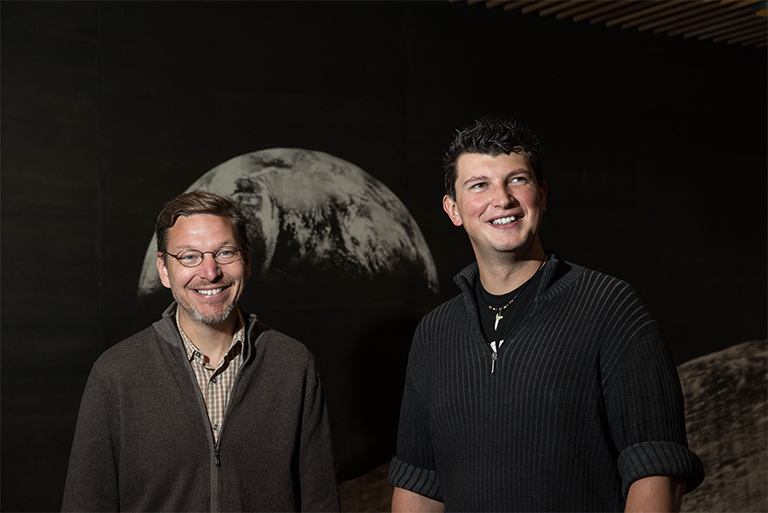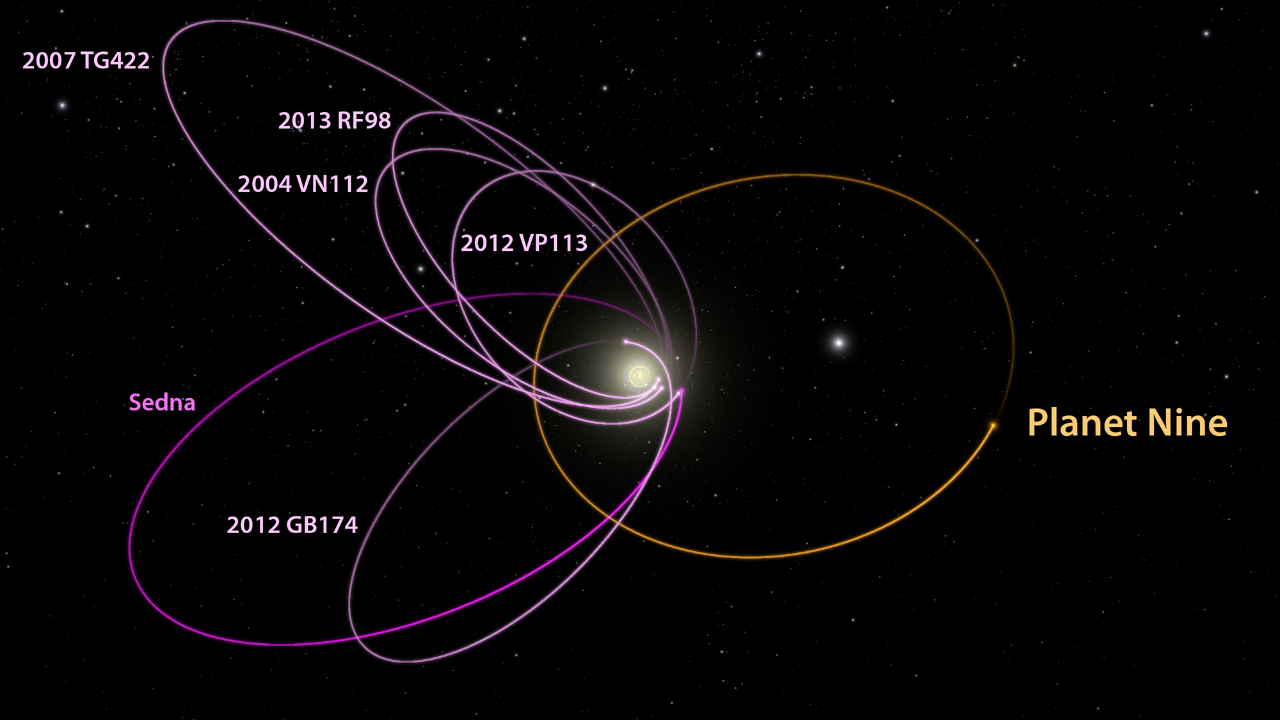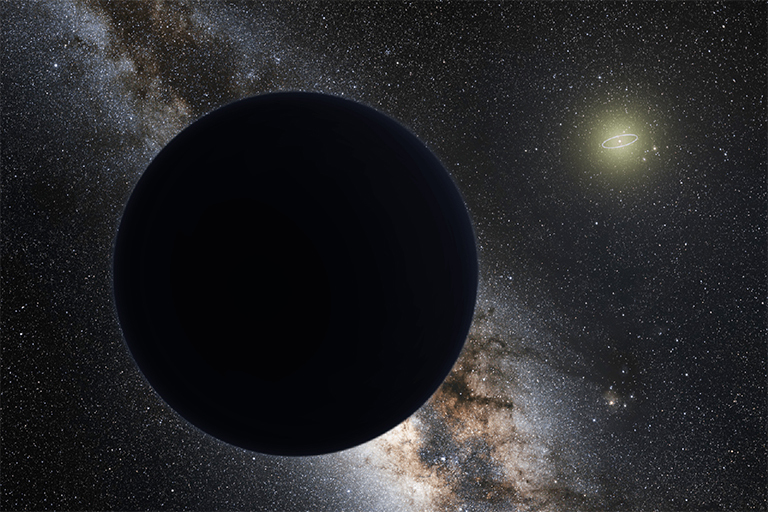Amanda Hendrix is a scientist who works on the Cassini mission at Saturn's Ultraviolet Imaging Spectograph. She is also co-lead for the Satellite Orbiter Science Team.
Alien Vs. Editor | October 6, 2017
Planet Nine
The super Earth that came home for dinner
It might be lingering bashfully on the icy outer edges of our solar system, hiding in the dark, but subtly pulling strings behind the scenes: stretching out the orbits of distant bodies, perhaps even tilting the entire solar system to one side.
If a planet is there, it’s extremely distant and will stay that way (with no chance – in case you’re wondering – of ever colliding with Earth, or bringing “days of darkness”). It is a possible Planet Nine, a world perhaps 10 times the mass of Earth and 20 times farther from the sun than Neptune. The signs so far are indirect, mainly its gravitational footprints, but that adds up to a compelling case nonetheless.
One of its most dedicated trackers, in fact, says it is now harder to imagine our solar system without a Planet Nine than with one.
“There are now five different lines of observational evidence pointing to the existence of Planet Nine,” said Konstantin Batygin, a planetary astrophysicist at Caltech whose team may be closing in. “If you were to remove this explanation, and imagine Planet Nine does not exist, then you generate more problems than you solve. All of a sudden, you have five different puzzles, and you must come up with five different theories to explain them.”
Batygin and his co-author, Caltech astronomer Mike Brown, described the first three breadcrumbs on Planet Nine’s trail in a January 2016 paper, published in the Astronomical Journal. Six known objects in the distant Kuiper Belt, a region of icy bodies stretching from Neptune outward toward interstellar space, all have elliptical orbits pointing in the same direction. That would be unlikely – and suspicious – enough. But these orbits also are tilted the same way, about 30 degrees “downward” compared to the pancake-like plane within which the planets orbit the sun.

Breadcrumb number three: Computer simulations of the solar system with Planet Nine included show that there should be more objects tilted with respect to the solar plane. In fact, the tilt would be on the order of 90 degrees, as if the plane of the solar system and these objects formed an “X” when viewed edge-on. Sure enough, Brown realized that five such objects already known to astronomers fill the bill.
Two more clues emerged after the original paper. A second article from the team, this time led by Batygin’s graduate student, Elizabeth Bailey, showed that Planet Nine could have tilted the planets of our solar system during the last 4.5 billion years. This could explain a longstanding mystery: Why is the plane in which the planets orbit tilted about 6 degrees compared to the sun's equator?
“Over long periods of time, Planet Nine will make the entire solar-system plane precess or wobble, just like a top on a table,” Batygin said.
The last telltale sign of Planet Nine’s presence involves the solar system’s contrarians: objects from the Kuiper Belt that orbit in the opposite direction from everything else in the solar system. Planet Nine’s orbital influence would explain why these bodies from the distant Kuiper Belt end up “polluting” the inner Kuiper Belt.
“No other model can explain the weirdness of these high-inclination orbits,” Batygin said. “It turns out that Planet Nine provides a natural avenue for their generation. These things have been twisted out of the solar system plane with help from Planet Nine and then scattered inward by Neptune.”

The remaining step is to find Planet Nine itself. Batygin and Brown are using the Subaru Telescope in Hawaii’s Mauna Kea Observatory to try to do just that. The instrument is the “best tool” for picking out dim, extremely distant objects lost in huge swaths of sky, Batygin said.
But where did Planet Nine come from? Batygin says he spends little time ruminating on its origin – whether it is a fugitive from our own solar system or, just maybe, a wandering rogue planet captured by the sun’s gravity.
“I think Planet Nine’s detection will tell us something about its origin,” he said.
Other scientists offer a different possible explanation for the Planet Nine evidence cited by Batygin. A recent analysis based on a sky mapping project called the Outer Solar System Origins Survey, which discovered more than 800 new “trans-Neptunian objects,” or TNOs, suggests that the evidence also could be consistent with a random distribution of such objects. Still, the analysis, from a team led by Cory Shankman of the University of Victoria, could not rule out Planet Nine.
If Planet Nine is found, it will be a homecoming of sorts, or at least a family reunion. Over the past 20 years, surveys of planets around other stars in our galaxy have found the most common types to be “super Earths” and their somewhat larger cousins – bigger than Earth but smaller than Neptune.
Yet these common, garden-variety planets are conspicuously absent from our solar system. Weighing in at roughly 10 times Earth’s mass, the proposed Planet Nine would make a good fit.
Planet Nine could turn out to be our missing super Earth.
TAGS: PLANET NINE, PLANET, KUIPER BELT
JPL | March 8, 2010
Smooth Sailing by Rhea and Helene
Cassini's closest-ever flyby of Saturn's moon Rhea went quite smoothly and teams are busy checking out their data! These flybys never fail to amaze me. And the raw images -- which give us an unprocessed first look -- are really cool!
This raw image (N00152175) from Cassini's narrow-angle camera image was taken about 40 minutes after closest approach. The image shows a region adjacent to the wispy terrain --craters, craters everywhere! And wow, are those crater rims bright compared to the surrounding terrain.
Cassini captured a full portrait of the serene moon with its wide-angle camera (raw image W00063107) on the outbound leg of the flyby, about 1.25 hours after closest approach. Keep in mind that the phase angle is quite low here (only about 2.5 degrees), meaning that the sun is almost directly behind Cassini and Rhea is nearly fully illuminated -- so there are no shadows. Large-scale albedo variations are apparent across the surface.
The spacecraft also obtained a cool image of little Helene with raw image N00152211. We're basically looking at the night side of the body -- but it doesn't appear very dark, because it's illuminated by sunlight reflecting off Saturn. During the later image sequence of Helene, this small moon was transiting Saturn - so you can see Saturn in the background. Sometimes,pointing at these little guys can be very tricky, especially so close after a targeted flyby. It can be difficult (or impossible!) to get the positions of the spacecraft, the moon and the instruments all lined up -- but boy are these close-up Helene images incredible! The detail on the surface is tremendous, and should go a long way to informing geologists about surface properties and processes.
As the imaging team is taking a closer look at images such as these, other instrument teams -- including those for the radar instrument, composite infrared spectrometer, visual and infrared mapping spectrometer and the ultraviolet imaging spectrograph (the instrument I work on) -- are also busy processing their data. At a science meeting Friday, we talked about a few of the preliminary results. Some of the magnetospheric and plasma science instruments teams reported that they’re seeing some really interesting and surprising results! So stay tuned to hear more about those!
Of course, after one successful flyby, we get right to work on another. Coming up next: Dione on April 7!
TAGS: SOLAR SYSTEM, SATURN, CASSINI, FLYBY, RHEA
JPL | March 1, 2010
Road-Tripping to Rhea with Cassini
Here in Cassini-land, we are really excited about Tuesday's Rhea flyby! This will be the mission's second targeted flyby of the moon in the mission, so it's sometimes referred to as R-2 or Rhea-2.
The spacecraft will fly by Rhea at an altitude of about 100 kilometers (60 miles), the closest encounter yet with Saturn's second largest moon. (Our first targeted flyby of Rhea in 2005 was at an altitude of 500 kilometers, or 300 miles, so this is way closer.)
We've been focusing a lot on the moon Enceladus because it is sort of the darling of the Saturn system -- but Rhea is a good example of why the other moons are interesting too. We know a decent amount about this moon, but we still have more questions, especially about the debris that could make up a ring around the moon and the composition of its surface.
The first targeted flyby in 2005 was focused on a radio science experiment doing gravity measurements to understand Rhea's interior structure. We also got some nice remote-sensing data from the cameras and spectrometers (see for example PIA07764) as well as radar measurements for surface and subsurface composition. We also did a much more distant flyby (5,000 kilometers or 3,000 miles) of Rhea in August 2007; that flyby was dedicated to remote sensing of the moon, including imaging (such as PIA08402). So we have a pretty good understanding of Rhea as being pretty heavily cratered with no super obvious signs of activity. It has this "wispy terrain" (see PIA08120), which is a lot like the type of feature seen on another Saturnian moon, Dione, and is basically a large series of fractures that are relatively bright compared to the surrounding regions.
One of the most interesting results to come out of the 2005 and 2007 flybys came from the fields and particles instruments: the mysterious signature of electron depletion around Rhea, suggestive of a debris ring. (Basically, solid material appears to be absorbing electrons in the vicinity of Rhea.) So Rhea could be a moon with its own ring! The ring has not been seen by any of the remote sensing instruments on Cassini, however. It can be difficult to get the viewing geometry just right in order to see this type of thing -- recall that the Cassini cameras didn't definitely see Enceladus' plume until after being in orbit for more than one year!
Tuesday's flyby should give us some clues about the suspected debris disk around the moon, but the slam-dunk experiment to "see" Rhea's debris disk is what we call a stellar occultation through the ring plane - looking to see if debris particles or clumps block out light from stars. Unfortunately we won't get to do such an occultation on this flyby. This is a tricky experiment to do because you have to get the timing and the geometry just right, but we're hoping to do it at some point later in the mission.
Anyway, on to Tuesday's flyby! To get a sense of what we're going to do, check out the movie made by Cassini navigator Brent Buffington that shows each of the activities performed during the flyby.
We will approach Rhea on the night side, so the moon will be dark. This is an especially good opportunity for the radar instrument to make measurements. (The cameras and imaging spectrometers typically prefer to observe the dayside, not the nightside.) Radar will do synthetic aperture radar imaging scans similar to those at Titan and will also do measurements to understand the surface composition. Previous measurements had suggested an asymmetry in brightness (which could be due to compositional differences) between the leading and trailing hemispheres of the moon, so this flyby will help with investigating that.
At closest approach, the fields and particles instruments will take data that will help us understand the environment of Rhea -- its interaction with Saturn's magnetosphere, its debris disk, and its ejecta cloud density. Ejecta clouds are dust or material that is being ejected or sputtered or otherwise lost from Rhea and its environment and contributing to populations of neutral particles and plasma in the Saturn system. This material may also be contaminating Saturn's rings.
Outbound, the remote sensing instruments will take over. They will make measurements -- in wavelengths as short as the ultraviolet all the way to the far infrared -- of Rhea's surface terrains and composition, as well as its surface temperature. The cameras have seen some "bluish spots" that could be related to the debris ring material - so those regions will be investigated more during this encounter, as will the fractured "wispy" terrain. The visual and infrared mapping spectrometer and the ultraviolet imaging spectrograph will do imaging spectroscopy to search for and map out water ice grain sizes, carbon dioxide, ammonia and fine-grained iron particles, among other materials. The composite infrared spectrometer will map temperatures across portions of Rhea's sunlit disk at high resolution. Ninety minutes after closest approach, Rhea will enter Saturn's shadow, giving the composite infrared mapping spectrometer a good opportunity to measure the cooling of the surface, which will provide information about the texture of the uppermost surface layers.
But wait - there's more! Not only do you get a Rhea flyby, but we're going to throw in a close approach to the small moon Helene! Helene is one of the "co-orbitals" of Dione. That means it orbits Saturn at the same radial distance as Dione, but it happens to be 60 degrees ahead of Dione. Helene is only about 30 or 35 km across (19 or 22 miles) and it's not spherical (see PIA10544). Cassini will approach Helene within about 1,825 kilometers (1,130 miles) -- by FAR the closest we've ever gotten to Helene -- allowing the cameras and imaging spectrometers to obtain information about individual regions across the surface.
So this promises to be an exciting period. Please stay tuned to see the great results!
TAGS: SOLAR SYSTEM, SATURN, CASSINI, FLYBY, RHEA
JPL | November 5, 2008
Exciting Times for Cassini
It's an exciting time in Cassini-land these days! We are well into the Equinox Mission, an extension to Cassini's mission that includes seven flybys of the Saturnian moon Enceladus, discovered in July 2005 to be geologically active. Prior to the prime mission, we knew that Enceladus was interesting and unique, and thus planned and executed three targeted flybys for the prime mission. With the tremendous discovery of water plumes at the south pole of this small icy moon (which happened on the second targeted flyby), we planned a more in-depth investigation for the Equinox Mission. And we are well into it! Our first Enceladus flyby of the Equinox Mission was in August, and we had two in October.
My job on Cassini is two-fold: I am on the science planning team, helping to plan out the science activities that occur during each icy moon encounter, and I am on the team for the ultraviolet imaging spectrograph instrument, studying ultraviolet data of the surfaces of these icy moons. So it’s really fantastic to be involved in planning each encounter, and then analyzing data to understand the moons.
In order to learn as much as we can about crazy Enceladus (it's so small and icy -- yet it's got these geysers!), we want to let all of the instruments make measurements, and it isn't possible to simultaneously get measurements from all instruments. (That's just the way the spacecraft is built.) We know that the cameras will tell us a lot about the current and historical geology of the surface, the ultraviolet and infrared imagers will tell us about the surface composition, and the long-wavelength infrared instrument will reveal surface temperatures. These four "remote-sensing" instruments can take data simultaneously. But if we want to get the best data from the "in situ" instruments (like the ion and neutral mass spectrometer and cosmic dust analyzer), we need to orient the spacecraft such that it's nearly impossible to get remote sensing data. So we divide up the flybys and allow many instruments the opportunity to get data. The period around the closest approach during the August flyby (called "E4") was allocated to the remote-sensing instruments -- and this resulted in the highest-resolution images of the active "tiger stripes" ever! (See one of these images here: http://photojournal.jpl.nasa.gov/catalog/PIA11113) The closest approach of the next Enceladus flyby - called "E5," on October 9 -- took the spacecraft deeper into the south polar plume than ever before. Here the priority was given to the in situ instruments, which obtained great, high-signal data of the plume, telling us about the composition of both the gaseous and particle components. And the October 31 flyby - called "E6" -- was again dedicated to remote-sensing, for a last look at the south pole before it heads mostly into seasonal darkness.
It’s so fortunate that Cassini has multiple opportunities to execute close encounters of an object as dynamic as Enceladus. The Voyager spacecraft had just one shot as they flew through the Saturn system, but Cassini, as an orbiter, gives us the chance to analyze our data, figure out what we’ve learned, and make thoughtful decisions on what experiments we need to make to follow up on those discoveries.
Things aren’t completely within our control, however! For instance, southern summer in the Saturn system is coming to a close, limiting the amount of sunlight illuminating the fascinating south polar region of Enceladus. But there’s plenty of important science to do in the dark with the in situ instruments, as well as the composite infrared spectrometer and radar, which is great. Who knows — we’ll see what the equinox season (and hopefully the following solstice) has in store for us! We may get some surprises!
TAGS: SATURN, SOLAR SYSTEM, CASSINI, ENCELADUS, MOON








